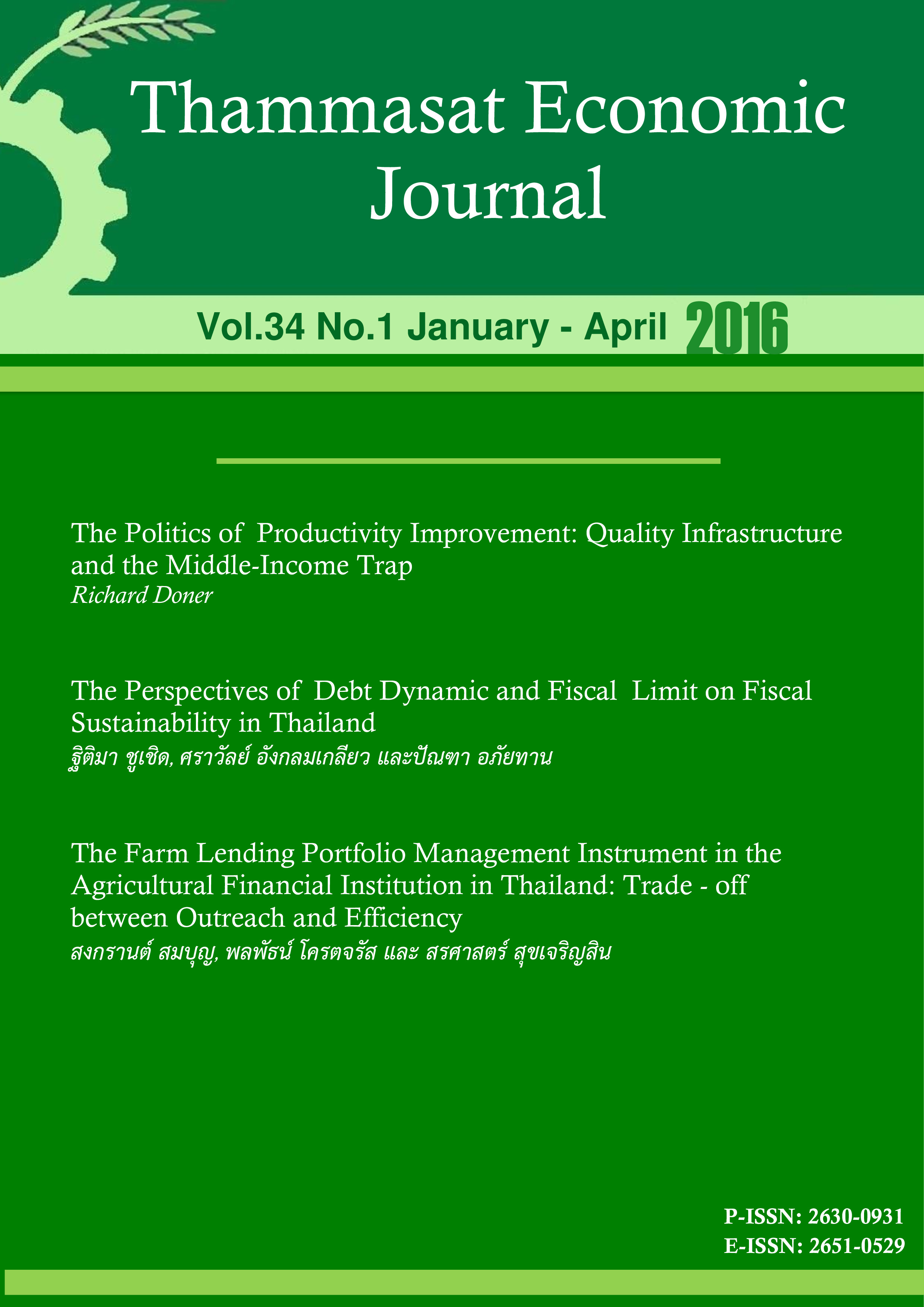The Perspectives of Debt Dynamic and Fiscal Limit on Fiscal Sustainability in Thailand
Keywords:
Fiscal sustainability, Public debt dynamic, Fiscal limit, Ageing Population, Fiscal Space, Fiscal crisisAbstract
This study assesses Thailand’s fiscal sustainability in two perspectives: debt dynamics and fiscal limits. Investigating ‘debt dynamics’ helps understand behaviors of fiscal policy that cause debt accumulation to project the future paths. ‘Fiscal limits’ can be used as a tool to examine the country’s maximum debt level based on economic fundamentals which the government is able and willing to service over the finite horizon. The study shows that Thailand has been facing a fiscal mismatch between its revenue and expenditure. After entering the aged society, healthcare costs and other aged-related spendings are expected to grow remarkably causing an exponential increase in the public debt to GDP ratio in the near future. The ratio tends to grow faster taking into account a lower potential economic growth under new environments of supply-side constraints and an interest ratenormalization. If the government makes a strong commitment to fiscal reforms, the adjustment could alleviate fiscal mismatch and provide sufficient policy space to withstand any unexpected shocks to the Thai economy and/or the financial system. Hence, fiscal reform efforts at the early stage could promote fiscal sustainability and lower probability of future fiscal crisis.
References
ฐิติมา ชูเชิด, ศราวัลย์ อังกลมเกลียว, และ ปัณฑา อภัยทาน. (2557). “สร้างรากฐานความยั่งยืนทางการคลัง...สู่เสถียรภาพระบบการเงินไทย.” ในงานสัมมนาวิชาการประจำปี 2557, ธนาคารแห่งประเทศไทย, ตุลาคม.
ณัฐพล ศรีพจนารถ และณัฐพล สุภาดุลย์. (2556). “ความเสี่ยงทางการคลังจากการเข้าสู่สังคมผู้สูงอายุ.”, รายงานฉบับสมบูรณ์, สัมมนาวิชาการเวทีสำนักงานเศรษฐกิจการคลังประจำปี 2556, สำนักงานเศรษฐกิจการคลัง, สิงหาคม.
ทรงธรรม ปิ่นโต, บุณยวรรณ หมั่นวิชาชัย, และฐิติมา ชูเชิด. (2550). “การประเมินความยั่งยืนทางการคลังของไทย:ความเสี่ยง และนัยต่อการดำเนินนโยบายในอนาคต.” ในงานสัมมนาวิชาการประจำปี 2550,ธนาคารแห่งประเทศไทย, ตุลาคม.
นรพัชร์ อัศววัลลภ. (2556). “พื้นที่การคลัง (Fiscal Space) กับกรอบความยั่งยืนทางการคลังของกระทรวงการคลัง.”, ประมาณการเศรษฐกิจไทยปี 2556 และปี 2557, กันยายน น. 77-83,.
วรพัฒน์ เจนสวัสดิชัย, สาวิตรี สัจจาภินันท์, อัศวานุชิต, บุณยวรรณ หมั่นวิชาชัย, และวิลดา มีแย้ม. (2545). “ความยั่งยืนทางการคลังกับเป้าหมายเงินเฟ้อ: การผสมผสานนโยบายที่เหมาะสม.”, ในงานสัมมนาวิชาการประจำปี 2545, ธนาคารแห่งประเทศไทย, สิงหาคม.
วิมล ชาตะมีนา. (2551). “การศึกษาภาระทางการคลังจากการให้สวัสดิการทางสังคมของรัฐบาล ในกรณีศึกษาโครงการประกันสังคมและโครงการหลักประกันสุขภาพถ้วนหน้า.” รายงานโครงการวิจัยฉบับสมบูรณ์, สำนักงานเศรษฐกิจการ คลัง, สิงหาคม.
วุฒิพงศ์ จิตตั้งสกุล และคณะ. (2555). “การศึกษาเพื่อวิเคราะห์แนวโน้มรายจ่ายด้านสวัสดิการสังคมของภาคสาธารณะเมื่อเข้าสู่สังคมผู้สูงอายุ.” รายงานโครงการวิจัยฉบับสมบูรณ์, สำนักงานเศรษฐกิจการคลัง, พฤศจิกายน.
สถาบันวิจัยเพื่อการพัฒนาประเทศไทย. (2555). “การประมาณการงบประมาณสำหรับผู้สูงอายุและแหล่งที่มาของเงิน” โครงการวิจัย, สถาบันวิจัยเพื่อการพัฒนาประเทศไทย สำนักส่งเสริมและพิทักษ์ผู้สูงอายุ และสำนักงานส่งเสริมสวัสดิภาพและพิทักษ์เด็ก เยาวชน ผู้ด้อยโอกาส และผู้สูงอายุ, มีนาคม.
สำนักงานบริหารหนี้สาธารณะ. (2553). “ภาระผูกพันทางการคลังของรัฐบาล : หนี้สาธารณะที่ซ่อนเร้น.” โครงการวิจัย, สำนักงานบริหารหนี้สาธารณะ.
สำนักนโยบายการคลัง. (ม.ป.ป.). รายงานความเสี่ยงทางการคลัง ปีงบประมาณ 2554– 2557 (ฉบับสมบูรณ์). สำนักงานเศรษฐกิจการคลัง.
สุรจิต ลักษณะสุต, พิสิทธิ์ พัวพันธุ์, จารุพรรณ วานิชธนันกุล, คธาฤทธิ์ สิทธิกูล, อุทุมพร จิตสุทธิภากร, และ จงกลคำไล้. (2553). “ความท้าทายของนโยบายการคลัง: สู่ความยั่งยืนและการขยายตัวทางเศรษฐกิจระยะยาว.” ในงานสัมมนาวิชาการประจำปี 2553, ธนาคารแห่งประเทศไทย.
Bi, H. (2011). “Sovereign Default Risk Premia, Fiscal Limits and Fiscal Policy.” Working Paper 2011-10, Bank of Canada.
_____________. (2012). “Sovereign Default Risk Premia, Fiscal Limits and Fiscal Policy.” European Economic Review, 56(2012), 389-410.
Combes, J., Debrun, X., Minea, A. and R. Tapsoba. (2014). “Inflation Targeting and Fiscal Rules: Do Interactions and Sequencing Matter?” IMF Working Paper 14-89, International Monetary Fund.
Escolano, J. (2010). “A Practical Guide to Public Debt Dynamics, Fiscal Sustainability, and Cyclical Adjustment of Budgetary Aggregates.” Technical Note and Manuals, Fiscal Affairs Department, International Monetary Fund, January.
Escolano, J., Shabunina, A. and J. Woo. (2011). “The Puzzle of Persistently Negative Interest Rate-Growth Differentials: Financial Repression or Income Catch-Up?” IMF Working Paper 11-260, International Monetary Fund, November.
European Commission. (2012). Fiscal Sustainability Report, European Economy 8/2012.
_____________. (2013). Report on Public Finances in the EMU, European Economy 4/2013.
Fedelino, A., Ivanova, A. and M. Horton. (2009). “Computing Cyclically Adjusted Balances and Automatic Stabilizers”, Technical Note and Manuals, Fiscal Affairs Department, International Monetary Fund, November.
Girouard, N. and André, C. (2005). “Measuring Cyclically-Adjusted Budget Balances for OECD Countries.” Economics Department Working Papers No. 434, July.
Herdon, T., Ash, M. and R. Pollin. (2013). “Does High Public Debt Consistently Stifle EconomicGrowth? A Critique of Reinhart and Rogoff.” Working Paper 322, Political Economy Research Institute.
Hopf, G. (2009). Saving and Investment: the Economic Development of Singapore 1965-99. LSE Research Online, The London School of Economics and Political Science.
International Monetary Fund. (2008). “Debt Sustainability Analysis for Market Access Countries.” Staff Guidance Note, July.
_____________. (2011a). “Addressing Fiscal Challenges to Reduce Economic Risks.” Fiscal Monitor, September.
_____________. (2011b). “Modernizing the Framework for Fiscal Policy and Public Debt Sustainability Analysis.” Fiscal Affairs Department and Strategy, Policy, and Review Department, August.
_____________. (2013a). “Fiscal Adjustment in an Uncertain.” Fiscal Monitor, April.
_____________. (2013b). “Reassessing the Role and Modalities of Fiscal Policy in Advanced Economies.”
IMF Policy Paper, September.
_____________. (2013c). “Taxing Times.” Fiscal Monitor, October.
_____________. (2014). “Public Expenditure Reform Making Difficult Choices.” Fiscal Monitor, April.
Ješić, M. (2013). “Implications of Fiscal Irresponsibility on Financial Stability.” Journal of Central Banking Theory and Practice, 3, 111-138.
Lindgren, C., Baliño, T., Enoch, C., Gulde, A., Quintyn, M. and L. Teo. (1999). “Financial Sector Crisis and Restructuring – Lessons from Asia.” IMF Occasional Paper 188, International Monetary Fund.
Mourre, G., Isbasoiu, G., Paternoster, D. and M. Salto. (2013). “The Cyclically-Adjusted Budget Balance Used in the EU Fiscal Framework: an Update.” European Commission, Economic Papers 478, March.
Ostry, J.D., Ghosh, A.R., Kim, J.I., and M.S. Qureshi. (2010). “Fiscal space.” Staff Position Note No.10/11, International Monetary Fund.
Pescatori, A., Sandri, D. and J. Simon. (2014). “Debt and Growth: Is There a Magic Threshold?” IMF Working Paper 14-34, International Monetary Fund.
Polackova, H. (1989). “Contingent Government Liabilities: A Hidden Risk for Fiscal Stability.” Policy Research Working Paper, World Bank.
Reinhart, C.M. and K.S. Rogoff. (2010). “Growth in a Time of Debt.” American Economic Review: Papers & Proceedings, 100(2), 573-78.
Reinhart, C.M., Reinhart V.R., and K.S. Rogoff. (2012). “Public Debt Overhang: Advanced-Economy Episodes since 1980.” Journal of Economic Perspectives, 26, 69-86.
Ulbrich, J. (2013). “Fiscal Limits, Financial Stability and Monetary Policy.” Presentation for Chief Economists’ Workshop at the Bank of England, Deutsche Bundesbank, May.
Weber, A. (2012). “Stock-Flow Adjustments and FiscalTransparency: A Cross-Country Comparison.” IMF Working Paper 12-39, International Monetary Fund.










